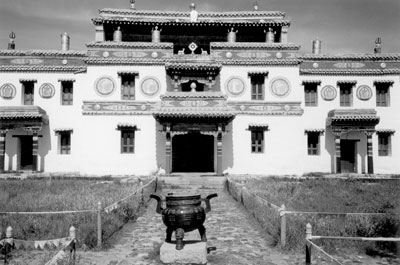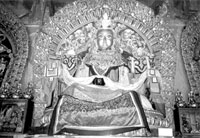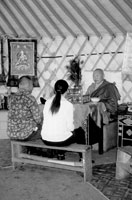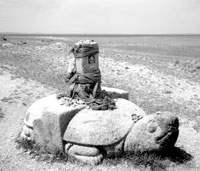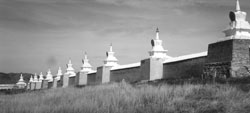In search of Chinggis Khan
by Julie Skurdenis, part one of two
By all accounts, Genghis Khan was not a nice guy. Nice guys finish last, and Genghis Khan was determined not to be at the back of the pack. In the late 1100s and early 1200s, this Mongol warrior carved out a vast empire that stretched from Beijing to the Caucasus Mountains in Western Asia. His capital was in Karakorum in central Mongolia, 240 miles southwest of Ulaan Baatar, Mongolia’s present capital.
With my husband, I traveled halfway ’round the world to visit the site of that ancient city and to attend Mongolia’s foremost festival, Naadam, held each year in mid-July.
My education in things Mongolian began within minutes of arrival in Ulaan Baatar in July ’04. Our guide, Tamara, a no-nonsense young woman of Russian-Mongolian parents, told me that it was not Genghis (either hard “g” or soft “j”) Khan I was seeking but Chinggis Khan (“ch”as in China).
“No matter,” she said, “most foreigners make the same mistake.”
Chinggis Khan — meaning something like “King of Everything,” according to Tamara — was the title conferred on the 27-year-old warrior whose birth name was Terniijin and whom the other Mongol tribal leaders acknowledged as their leader in 1189.
Chinggis’ capital
When asked if anything was left of Karakorum, Tamara smiled and said, “Well, yes and no.” About 1220, Chinggis Khan made Karakorum, a site already occupied for 400 or 500 years, his capital. But he died seven years later and it was his son, Ogedei Khan, who built a palace and temples and enclosed them all within walls pierced with four gates.
Chinggis Khan’s capital survived little more than 40 years. In 1264, Chinggis’ grandson, Kublai Khan, moved his capital to Khanbalik, present-day Beijing. Karakorum was all but abandoned and eventually was destroyed by Manchurian invaders in the following century. In the 16th century, the stones of Karakorum were used to build the Buddhist monastery of Erdene Zu, which survived for three and a half centuries until it too was all but destroyed by the Russians in the 1930s.
Not much is left of ancient Karakorum, although Erdene Zu, one of Mongolia’s architectural and artistic treasures, lies atop the ruins. What is left from Chinggis Khan’s days are “turtle stones” that once marked the boundaries of the 13th-century city. There were four of these, each shaped like a large turtle with a tall, inscribed stele on its back.
Two are left: one is a short walk from the northern gate of the monastery past dozens of vendors selling souvenirs. The other is on a hill about a mile away and not easy to find without a guide. But, once there, visitors have a panoramic view over the entire monastery complex and a few more vendors in case you didn’t stock up at the previous opportunity.
Erdene Zu Monastery
Erdene Zu lies enclosed within immense stone walls studded with 108 stupas, dome-shaped Buddhist monuments sometimes housing relics of Buddha. Construction of the monastery began at the end of the 16th century, 200 years after the Manchurians had razed Karakorum. It is estimated that there were once as many as a hundred temples crowded within the complex, with more than 1,000 Buddhist monks living within.
In the 1930s Joseph Stalin destroyed Erdene Zu as well as other Mongolian monasteries and executed or exiled the monks. Only now, since Mongolia regained its independence in 1990, have monks returned and are the buildings being restored or reconstructed.
What remains gives a good idea of what once existed. Three temples stand shoulder to shoulder within a compound close to the monastery’s entrance. Each is dedicated to one of the stages of Buddha’s life — childhood, adolescence or adulthood — and each is crammed with treasures that somehow survived the destruction of the 1930s. There are statues of Buddha as well as of various deities (some carved by Mongolia’s greatest sculptor, Zanabazar, who lived from 1635 to 1723); ceremonial tsam masks used by monks in religious ceremonies, and brightly colored scroll paintings.
Nearby is a gigantic stupa built about 1800 and, next to it, a large white temple, called the Lavrin Süm, that looks as if it could have come from Lhasa, Tibet. Visitors can hear monks in saffron robes chanting prayers. The morning we visited, two young monks stood on a wooden platform outside the temple blowing on large white conch shells, calling other monks to prayer. It was one of those sublime moments when you feel far removed from home and very much part of what you’ve traveled so far to experience.
Not much is left of Chinggis Khan’s city, but somehow it doesn’t much matter. It was wonderful to be at Erdene Zu where that ancient city once stood, surrounded by monks who are slowly bringing the monastery back to life again. Also a nice contrast — the site of Chinggis Khan’s center of power is once again becoming a place where monks can freely chant their prayers.
Julie received a partial discount traveling with Bestway Tours & Safaris (800/663-0844). More on that company next month as she describes Mongolia’s biggest holiday, Naadam.

